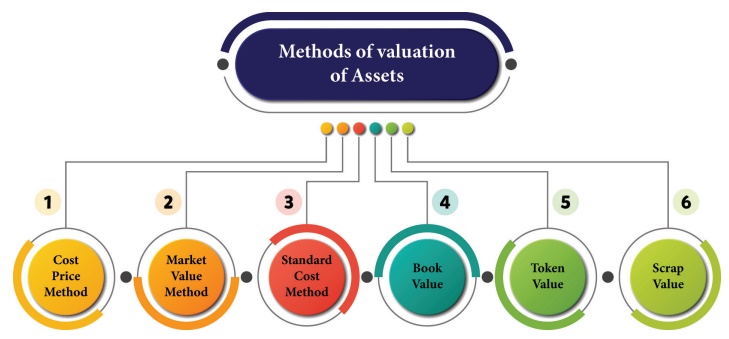Auditing - Valuation: Meaning, Definition, Objectives, Methods | 12th Auditing : Chapter 4 : Verification and Valuation of Fixed Assets
Chapter: 12th Auditing : Chapter 4 : Verification and Valuation of Fixed Assets
Valuation: Meaning, Definition, Objectives, Methods
Valuation
Meaning
Valuation
means finding out correct value of the assets on a particular date. It is an
act of determining the value of assets and critical examination of these values
on the basis of normally accepted accounting standard. Valuation of assets is
to be made by the authorized officer and the duty of auditor is to see whether
they have been properly valued or not. For ensuring the proper valuation,
auditor should obtain the certificates of professionals, approved values and
other competent persons. Valuation is the primary duty of company officials.
Auditor can rely upon the valuation of concerned officer but it must be clearly
stated in the report because an auditor is not a technical person. Without
valuation, verification of assets is not possible.
If the
valuation of assets is not correct, both the financial statements such as
Balance Sheet and Profit and Loss Account cannot be correct. Hence, the auditor
must take utmost care while valuing the assets to show true and fair view of
the state of affairs of the financial position of the concern.
Definition
R.Batliboi, “A company’s Balance Sheet is not drawn for the
purpose of showing what the capital would be worth if the assets were realized
and liabilities paid -off, but to show how the capital stands invested”.
Joseph Lancaster, “The valuation of assets is therefore an
attempt to equitable distribution of the original outlay on the period of the
assets usefulness”.
Objectives of Valuation
1.
To assess the correct financial position of the
concern.
2.
To enquire about the mode of investment of the
capital of the concern.
3.
To assess the goodwill of the concern.
4.
To evaluate the differences in the value of the
asset as on the date of purchase and on the date of Balance Sheet.
Methods Of Valuation
Valuation
of various assets can be made by using different methods of valuation of fixed
assets. Some of the major methods are as follows:

1. Cost Price Method
In this
method, valuation of assets is made on the basis of purchase price of the
assets. This price refers to the price at which an asset is acquired plus
expenses incurred in connection with the acquisition of an asset. It is a very
simple method of valuing assets.
2. Market Value Method
Valuation
of assets can be made on the basis of market price of such assets. But if same
nature of assets is not available in the market, it is very difficult to
determine the value of such assets. So, there are two methods related to it.
They are:
i. Replacement Value Method
It
represents the value at which a given asset can be replaced. This method of
valuation of assets can be done only in the case of replacement of the same
asset.
ii. Net Realizable Value
It
refers to the price in which such asset can be sold in the market. But
expenditure incurred at the sale of such asset should be deducted.
3. Standard Cost Method
Some of
the business organizations fix the standard cost on the basis of their past
experience. On the basis of standard cost, they make valuation of assets and
present in the Balance Sheet.
4. Book Value
This is
the value at which an asset appears in the books of accounts. It is usually the
cost less depreciation written off so far.
5. Going concern or Historical Value or
Conventional Value or Token Value
It is
equivalent to the cost less a reasonable amount of depreciation written off. No
notice is taken of any fluctuation in the price of the assets. Reason for this
is that these assets are acquired for use in the business and not for resale.
6. Scrap Value
This
method shows the value realized from sale of an asset as scrap. In other words,
it refers to the value, which may be obtained from the assets if it is sold as
scrap.
Auditor’s Duty as Regards Valuation
In a
legal case against Kingston Cotton Mills Co: It was held that “although it is
no part of an Auditor's’ duty to value the assets and liabilities, yet he must
exercise reasonable skill and care in scrutinizing the basis of valuation. He
should test the accuracy of the values put by the officers of the business. In
any case, the auditor cannot guarantee the accuracy of the valuation”.
It is
not an auditor's duty to determine the values of various assets. It has been
judicially held that he is not a valuer or a technical man to estimate the
value of an asset. But he is definitely concerned with values set against the
assets. He has to certify that the profit and loss account shows true profit or
loss for the year and Balance Sheet shows a true and fair view of the state of
affairs of the company at the close of the year. Therefore he should exercise
reasonable care and skill, analyse all the figures critically, inquire into the
basis of valuation from the technical experts and satisfy himself that the
different classes of assets have been valued in accordance with the generally
accepted assumptions and accounting principles. If the market value of the
assets are available i.e., in the case of share investment then he should verify
the market value with the stock exchange quotations. If there is any change in
the mode of the valuation of an asset, he should seek proper explanation for
it. If he is satisfied with the method of valuation of the assets he is free
from his liability.
Related Topics